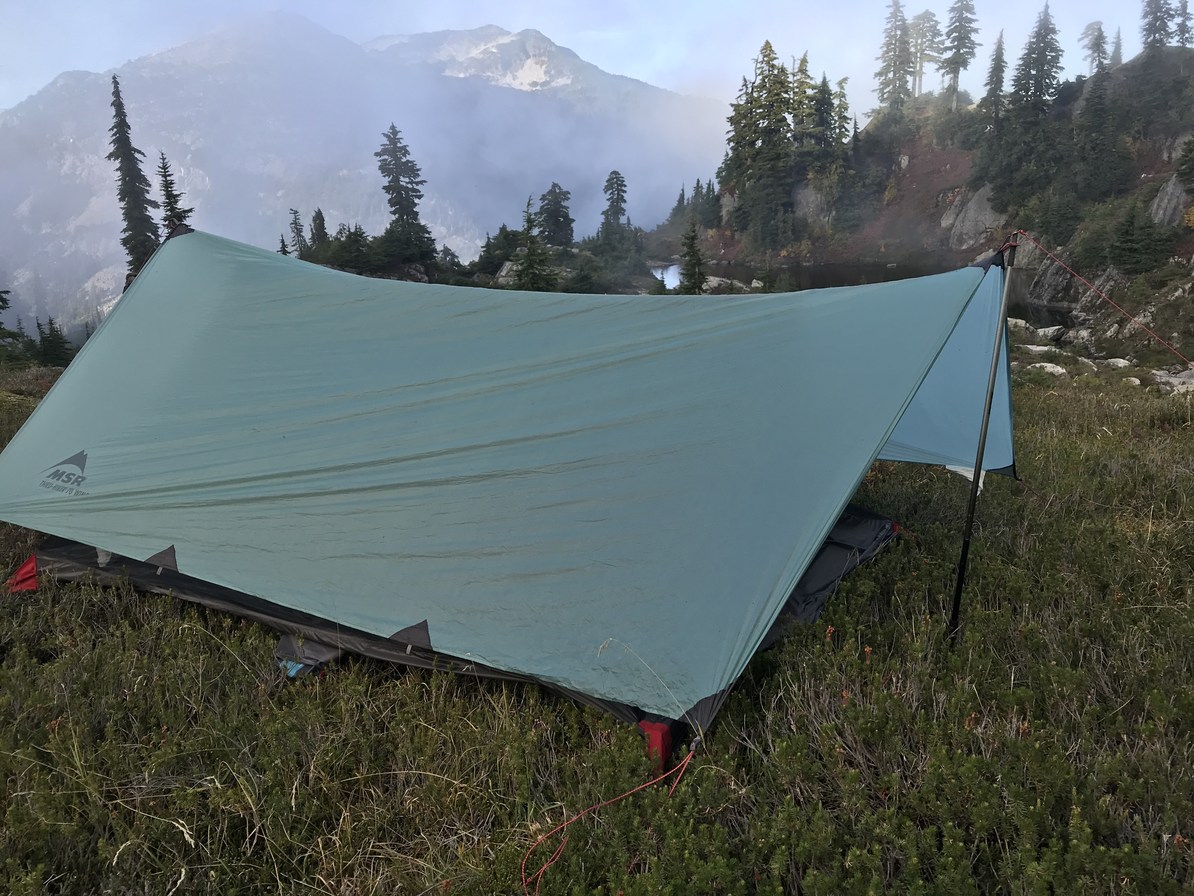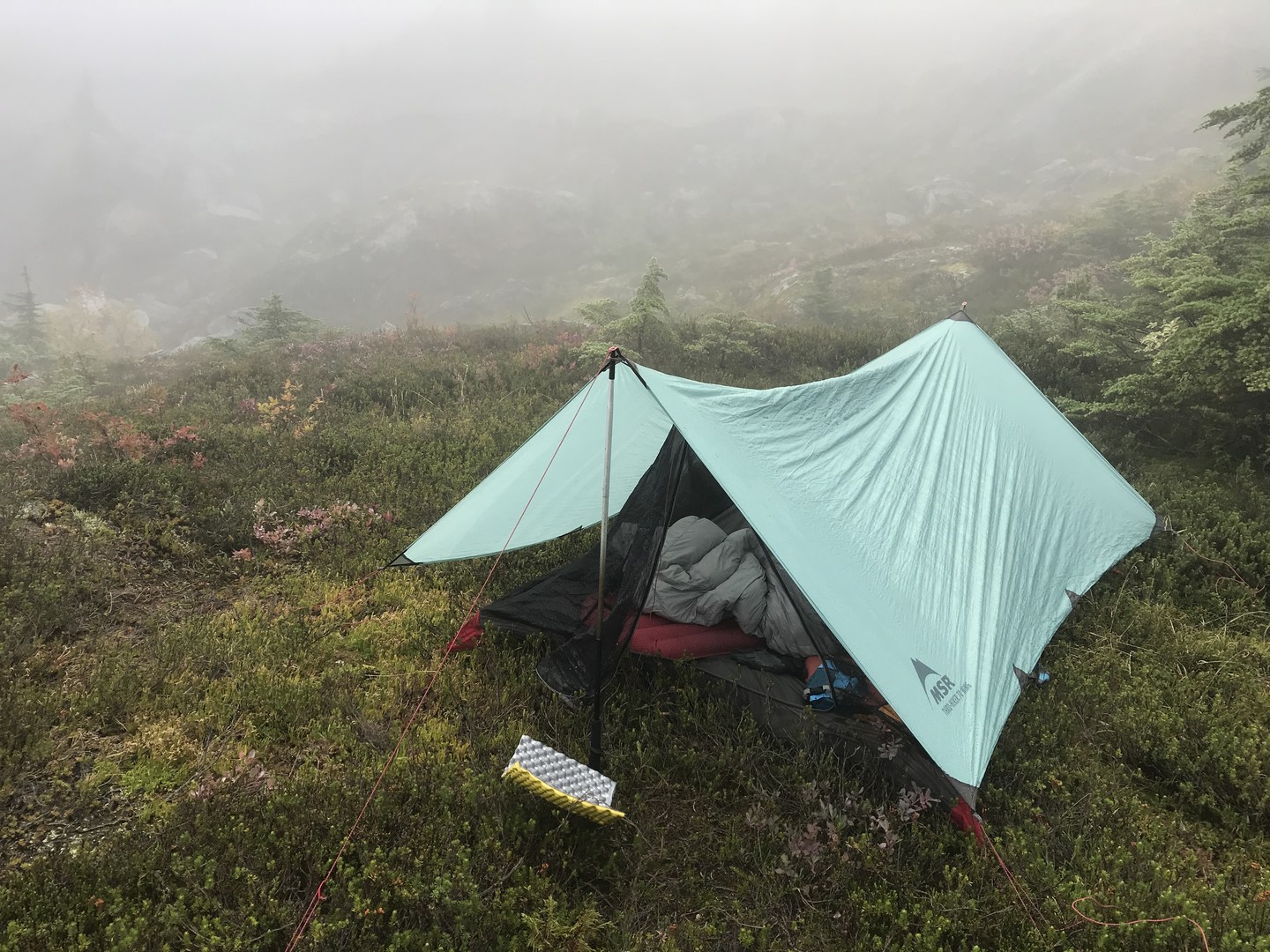MSR Thru-hiker System specs
- Weight:
- Mesh House 3: 570 g
- Wing 70: 460 g
- Footprint: 312 g
- Total: 1.342kg (1.180kg with Tyvek)
- Small pack sizes
- Comes with guy lines
- Trekking pole setup (not free standing)
Where to get it
- Price:
- Mesh House 3: $250
- Wing 70: $180
- Footprint: $40
- MSR: Mesh House 3, Wing 70, Footprint
- Amazon: Mesh House 3, Wing 70, Footprint
- Backcountry: Mesh House 3, Wing 70, Footprint
- Moosejaw: Mesh House 3, Wing 70, Footprint
The Bottom Line: This tricky system can be a bit of challenge for some decent drops in weight. Unfortunately it has a few key challenges that make it a little too hyper-specific. The gossamer thin floor makes the very heavy footprint essential for anything but platform camping, so what lightweight benefits it has are almost lost.

The MSR Thru-hiker System. Photo by Tam McTavish.
I only received this item very recently from Outdoor Project and MSR as a prize. I'd been looking for an ultralight shelter for a while, and this tent was definitely on my list. It has only been used in the mountains twice. One trip was a very wet and foggy night with some rain, and the second was a bluebird weekend. The first thing I need to acknowledge is that this is an ultralight shelter, which means it is going to be more finicky and full of idiosyncrasies not found in normal gear.
Setting up the Thru-hiker is a little challenging. First off, grass or thick dirt are the ideal surfaces because staking this out precisely is required. On rocky ground, using piles of boulders never gets quite the same tension exactly where you need it. Key guylines do have their own adjustment systems where the poles are, but otherwise you are going to need be good at tying a trucker's hitch to get all sides taught. I find initial setup takes about 10 to 15 minutes, and then there is normally another 10 to 15 minutes of fiddling about getting everything just tight enough. This does make the tent more wind resistant than I had anticipated. Mine survived short gusts that felt like about 25 km/h at their peak.
The Mesh House is spacious, though the middle person is going to feel the room a lot more then those on the sides, which are steeply sloped. Still, for an ultralight shelter, you have a lot of space.
You get just enough coverage for the Mesh House 3 with the MSR Wing 70, but your gear is going to be exposed because there is maybe a foot of extra space on each side. I use my Rab Siltarp 2 more often for this tent due to its superior coverage for wet weather. The back wall is not mesh, so it makes for a decent wind block in one direction.
One major issue with the tent is that the floor is really really thin. It feels like tissue, being 15 denier. This is great for lightweight packing, but using it without a footprint would be a very risky endeavor. The footprint is really heavy, coming in at just over 300 grams. It would have been far better if they had just launched the Mesh House at a heavier weight to begin with. My solution has been to use a Tyvek sheet that weighs half as much, but this is also a design flaw. The floor should have been 30 to 40 denier, or else a 15-denier footprint would have been much better. As it is, the shelter isn't that much lighter then the Big Agnes free-standing tents.
One big advantage to the MSR is it's versatility. Being able to use different tarp sizes is really handy, and it also means that in some instances you can get creative with how you place the tarp. The Mesh House is also light enough that it makes for a really good group shelter on buggy trips when you want to have a lunch stop or hang out in the evening without being eaten alive.
As it stands, the MSR is a finicky lightweight shelter. I can see this working for someone who is very weight conscious who is traveling in a group and staying on platforms or prepared dirt sites.





Comments
Sign In and share them.